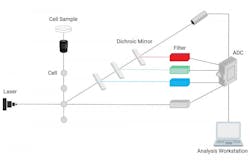Flow Cytometry Part1: Illuminating Cellular Diversity and Analysis
Flow cytometry is a revolutionary technique that enables the comprehensive analysis of cells or particles in a high-throughput manner. By harnessing the principles of hydrodynamic focusing, electronic detection, and optical systems, flow cytometry provides valuable insights into cell populations, surface markers, and complex cellular characteristics. This article explores the fundamental principles of flow cytometry, including the fluidic system, electronic detection system, equipment, and optical system. Understanding these principles is crucial for utilizing flow cytometry effectively in various fields, from immunology research to clinical diagnostics and beyond. Fluidic System: Hydrodynamic Focusing: At the heart of flow cytometry lies the fluidic system, specifically the concept of hydrodynamic focusing. This principle ensures that cells or particles in a suspension pass through the flow cytometer’s interrogation region in a single file, optimizing the accuracy and precision of measurements. High flow rates are employed for qualitative measurements, such as phenotyping cell populations based on surface markers. Lower flow rates are utilized for higher resolution analyses, including cellular and DNA analysis. Electronic Detection System: The electronic detection system in flow cytometry allows for the measurement of various properties of cells or particles. Forward-scattered light (FSC) measures the diffracted light slightly off-axis of the laser beam, providing information about the size of particles within a specific range. Side-scattered light (SSC) measures mostly refracted and reflected light at interfaces within cells, revealing information about cell complexity and granularity. These light scatter measurements provide valuable insights into cellular properties. Equipment: Flow cytometers are equipped with various components for efficient detection and analysis. Photomultiplier tubes (PMTs) are highly sensitive detectors used to capture weak SSC and fluorescence signals. They convert photons into electrical signals, enabling the detection of low-intensity events. Photodiodes, while less sensitive than PMTs, are employed to detect stronger FSC signals. Optical System: The optical system in flow cytometry is responsible for the proper routing and collection of light signals. Excitation optics include lasers and lenses that shape and focus the laser beam onto the sample. Emission optics consist of lenses, mirrors, filters, and beamsplitters that collect scatter and fluorescence signals, ensuring accurate detection. PMTs and photodiodes play crucial roles in capturing these signals, enabling the analysis of cellular properties. Flow cytometry is a versatile technique that offers unparalleled insights into the world of cells or particles. By understanding the principles of hydrodynamic focusing, electronic detection, equipment, and optical systems, researchers and clinicians can harness the full potential of flow cytometry. This technology has revolutionized various fields, from immunology and cancer research to drug discovery and clinical diagnostics. By utilizing flow cytometry effectively, scientists can uncover the intricate details of cell populations, surface markers, and complex cellular characteristics, leading to advancements in our understanding of biology and the development of targeted therapies. Avantier plays a vital role in the field of flow cytometry by providing specialized optical components and services tailored to the unique requirements of flow cytometers. Here are several key contributions that we can make: Avantier contributes to flow cytometry by providing tailor-made optical components, optimizing laser performance, designing fluorescence filters, enabling polarization measurements, assisting with optical system integration, and applying specialized coatings. These contributions enhance the capabilities of flow cytometry instruments, leading to improved accuracy, sensitivity, and versatility in cellular analysis and research. For more information to discover how tailored optical components enhance signal detection, reduce noise, and optimize the system for specific applications, read Flow Cytometry Part 2: Customized Optics – Advantages & Applications. Please contact us if you’d like to schedule a free consultation or request for quote on your next project.
